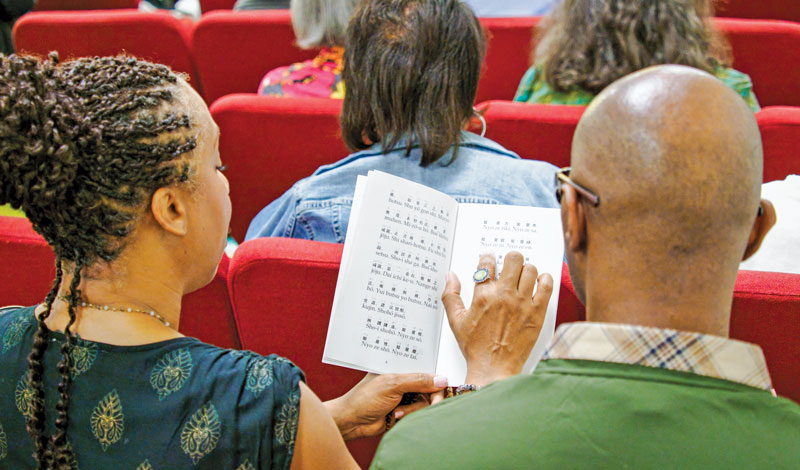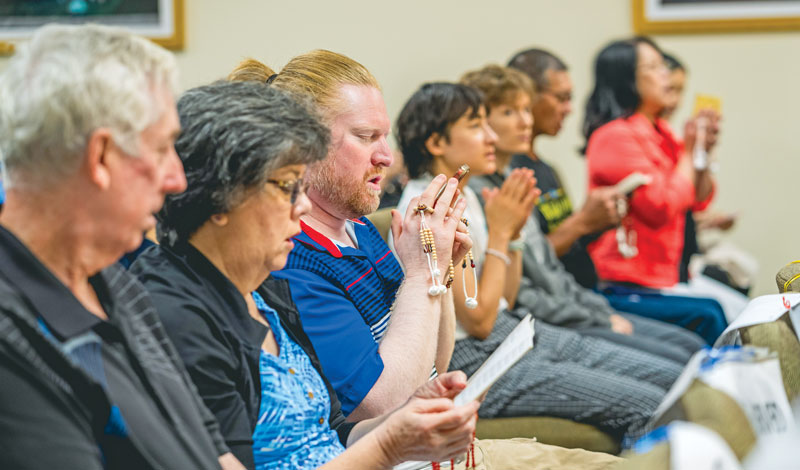“Gongyo, which forms a fundamental basis of our Buddhist practice, could be described as a ceremony in which we bring the primordial sun of Buddhahood to rise brightly in the vast skies of our lives each day.”(Ikeda Sensei, pp. 18–19 of this issue)
The first time a person hears about Nichiren Buddhism, odds are it’s the phrase Nam-myoho-renge-kyo. Soon enough, they’ll hear something a bit more complex sounding—the recitation of gongyo—and learn it’s an essential aspect of daily practice.
Ikeda Sensei has called gongyo a ceremony in which the microcosm of our lives harmonizes seamlessly with the macrocosm of the universe, writing:
It is a solemn ceremony through which we open wide the doors of the treasure storehouse within. We mine the dynamic wellspring of life force that lies dormant in the vast inner reaches of our being, and we tap an inexhaustible source of wisdom, compassion and courage. (Discussions on Youth, p. 219)
Even so, this daily practice can be difficult to sustain without grasping its significance and real benefit over time. In this issue, Living Buddhism addresses some of the most commonly asked questions about our practice of gongyo, including what it is, how its practice came about and how it helps us reveal an unshakable heart.
What is gongyo?
The Japanese word gongyo literally means “to exert oneself in practice” or “assiduous practice.”
As SGI members, gongyo consists of chanting Nam-myoho-renge-kyo and reciting portions of “Expedient Means,” the 2nd chapter of the Lotus Sutra, and “Life Span of the Thus Come One,” the 16th chapter, once in the morning and once in the evening.
What’s the difference between chanting Nam-myoho-renge-kyo and reciting gongyo?
Chanting Nam-myoho-renge-kyo can be likened to the main course of a meal, while reciting the sutra is the side dish. Sensei aptly explains that we need to eat from all food groups if we want to eat a nutritionally balanced diet (see Discussions on Youth, p. 220). A consistent practice of gongyo enables us to lead the most balanced and healthy lives in perfect harmony with the universe.
If there are 28 chapters in the Lotus Sutra, why do we recite those two?
Nichiren Daishonin was asked about the recitation of the Lotus Sutra by a strong practitioner, the wife of a Confucian scholar who had converted to his teachings after reading a draft of “On Establishing the Correct Teaching for the Peace of the Land.”
As was the practice in her day, she had been continuously reading through the sutra, a chapter a day, but then began reading only the “Medicine King” chapter.
While praising her efforts, Nichiren explains the formula he had established for reciting the sutra:
[T]hough no chapter of the Lotus Sutra is negligible, among the entire twenty-eight chapters, the “Expedient Means” chapter and the “Life Span” chapter are particularly outstanding. The remaining chapters are all in a sense the branches and leaves of these two chapters. Therefore, for your regular recitation, I recommend that you practice reading the prose sections of the “Expedient Means” and “Life Span” chapters. … The remaining twenty-six chapters are like the shadow that follows one’s body or the value inherent in a jewel. If you recite the “Life Span” and “Expedient Means” chapters, then the remaining chapters will naturally be included even though you do not recite them. (The Writings of Nichiren Daishonin, vol. 1, p. 71)
What am I essentially emphasizing when I recite the prose sections of those two chapters?
The Lotus Sutra’s 28 chapters can be divided into two parts: The first 14 chapters are referred to as the “theoretical teaching,” and the “Expedient Means,” the second chapter, is its central pillar.
During gongyo, we recite the opening and most important part of this chapter in which Shakyamuni reveals that the wisdom of all Buddhas lies in their awakening to the “true aspect of all phenomena”—which teaches that all people are Buddhas and that the Buddha’s mission is to lead all people to enlightenment.
Sensei writes: “‘You, yourself, are a Buddha. Revere the sun of Buddhahood in your own life.’ This is the essential teaching of the Lotus Sutra, the message of the ‘Expedient Means’ chapter” (The Heart of the Lotus Sutra, p. 19).
The last 14 chapters of the sutra compose the “essential teaching,” and its core is “Life Span,” the 16th chapter. The part we recite during gongyo reveals the heart of the essential teaching, which explains that Buddhahood is eternally present in the lives of all people and declares the great dignity and power of each person’s life.
In The Heart of the Lotus Sutra, Sensei recounts an episode in which second Soka Gakkai President Josei Toda’s lectured on the “Life Span” chapter of the Lotus Sutra. In his explanation of the phrase, “since I attained Buddhahood” (ji ga toku burrai) (see The Lotus Sutra and Its Opening and Closing Sutras, p. 270), President Toda explained the meaning of each word, clarifying that the phrase implicitly means “to attain, on one’s own, the three bodies of the Buddha.”
Sensei recalls:
When we heard this, everyone was taken aback. In the phrase ji ga toku burrai, which we had read many times without clearly understanding, the two characters ji and toku now stood out conspicuously. He thus taught that Buddhahood is a state of life we achieve from within, that Buddhahood inherently exists within our own lives. And the participants could fully grasp his meaning. (The Heart of the Lotus Sutra, p. 312)
The recitation of the “Expedient Means” and “Life Span” chapters of the sutra every morning and evening constitutes a practice that enables us to identify and praise the Buddha nature within. Sensei writes, “When one recites the ‘Expedient Means’ and ‘Life Span’ chapters, it increases and accelerates the primary practice’s beneficial power” (The Heart of the Lotus Sutra, p. 11).
You mentioned above that during Nichiren’s time some of his disciples would continually read the sutra, one chapter at time. What is the history of gongyo?
Nichiren Daishonin highlighted which chapters of the Lotus Sutra to recite, but the format of gongyo is not specified in his existing writings. As such, over the more than 700-year history of Nichiren Buddhism, the format of gongyo and the silent prayers have undergone numerous changes.
Up until the Soka Gakkai’s establishment in 1930, the recitation of the sutra was only conducted by priests. Lay practitioners relied on priests to pray on their behalf in exchange for monetary support. Soka Gakkai founding presidents Tsunesaburo Makiguchi and Josei Toda challenged the notion of “priest-based” faith and revived Nichiren Buddhism as a religion accessible to all people.
Presidents Makiguchi and Toda were imprisoned during World War II for refusing to incorporate the state religion of Shintoism into the practice of Nichiren Buddhism. Upon his release from prison, Josei Toda reestablished the daily practice of gongyo for lay practitioners, promoted study of Nichiren’s writings, continued the tradition of discussion meetings and encouraged all members to engage in propagation—empowering members to bring forth their inherent Buddha nature and help others do the same.

I heard that gongyo used to be longer but was condensed.
Yes, for many years, the Soka Gakkai practiced the “five- and three-prayers format” of gongyo, which consisted of repeating the sutra recitation five times in the morning and three times in the evening. In September 2004, the format of gongyo and the silent prayers was revised, moving to a single recitation of portions of the “Expedient Means” and “Life Span” chapters and chanting Nam-myoho-renge-kyo. And in 2015, the Soka Gakkai further revised the format of gongyo and silent prayers, making the format for both morning and evening the same and making the wording of the silent prayers more simple, accessible and easy to understand.
Sensei addressed the simplification of gongyo, saying: “The reason for this simplification of gongyo was to create an even greater current of worldwide kosen-rufu in the 21st century” (p. 19 of this issue). He continued:
The Daishonin writes that in the midst of the life-threatening Tatsunokuchi Persecution, he “recited the verse portion of the ‘Life Span’ chapter” (“The Actions of the Votary of the Lotus Sutra,” WND-1, 768). Some of his lay believers also “continued to recite the ten factors of life [of the ‘Expedient Means’ chapter] and the verse section of the ‘Life Span’ chapter and chant the daimoku [Nam-myoho-renge-kyo]” (“The Fourteen Slanders,” WND-1, 756). This is almost the same as the gongyo format that we now follow. (p. 20 of this issue)
Though the format may change again in the future, the fundamentals of chanting Nam-myoho-renge-kyo and reciting the sutra based on Nichiren’s teachings will never change. Sensei explains:
Formality is not important. There are no rigid formalities for gongyo laid down in the Daishonin’s writings. What counts is that gongyo refreshes and invigorates your lives.
Just as a morning walk or jog may be pleasantly exhilarating for both the body and the mind, please do a gongyo that is personally satisfying to you—one that leaves you feeling refreshed and uplifted both mentally and physically. (My Dear Friends in America, fourth edition, p. 273)
Why do gongyo twice a day?
We do certain things every day for our well-being, such as eating, sleeping and brushing our teeth. Similarly, we need a daily practice for our spiritual health. Sensei says that reciting the sutra is “a daily activity in which we purify and prime our hearts and minds” (Discussions on Youth, p. 215). He says, for example, that in the morning, it starts our engine for the day: “Some people have powerful engines, and some have weak engines. The strength of the engine dramatically affects what we accomplish throughout the course of our lives. … Diligently applying ourselves in our daily practice of the sutra recitation boosts the power of our engine” (Discussions on Youth, p. 215).
The trajectory of our lives is determined by what we do and how we live each day. Our practice of morning and evening gongyo is the driving force for continually improving our lives.

How does gongyo increase our life force?
When we recite the sutra and chant Nam-myoho-renge-kyo, through faith in the Gohonzon, “we vigorously infuse the microcosm of our individual existence with the life force of the macrocosm, of the entire universe” (Discussions on Youth, p. 215).
Practicing this fusion consistently morning and evening strengthens our inner core. Sensei writes:
As practitioners of Nichiren Daishonin’s Buddhism, we get up in the morning and do gongyo. Some perhaps may do so rather reluctantly! Nevertheless, doing gongyo is itself a truly great and noble thing. Gongyo is a solemn ceremony in which we are, in a manner of speaking, looking out and over the universe; it is dialogue with the universe.
Doing gongyo and chanting [Nam-myoho-renge-kyo] before the Gohonzon represent the dawn, the start of a new day, in our lives; it is the sun rising; it gives us a profound sense of contentment in the depths of our being that nothing can surpass. (My Dear Friends in America, fourth edition, p. 484)
In the morning, gongyo is a “wake-up song that causes the sun to rise in our hearts” and in the evening, “a ‘Moonlight Sonata’ that illuminates our hearts with the light of the moon” (see The Wisdom of the Lotus Sutra, vol. 6, p. 44). Morning and evening, reciting gongyo to the Gohonzon enables us to “rise up” and “lie down” with the Buddha, call forth the great life force of Buddhahood and powerfully manifest it in our daily lives.
What happens if I miss gongyo?
Ultimately, the most important thing is to carry out faith throughout your entire life. Sensei clarifies that as long as we maintain faith, we will not experience negative effects on account of occasionally missing gongyo. In fact, he assures us that, with faith, the seed of Buddhahood will continue to grow.
However, Sensei also shares that the degree to which we exert ourselves in faith will determine the kind of benefits we gain: “Doing gongyo is a right, not an obligation. Because Buddhism entails practice, tenacious efforts are required, but these are all for your own sake. If you want to have great benefits or to develop a profound state of life, you should exert yourself accordingly” (My Dear Friends in America, fourth edition, p. 77).
Gongyo enables us to polish our lives and as we challenge ourselves to do it morning and evening, we can activate our highest potential, eventually establishing Buddhahood as our fundamental state of life.
Sensei writes of our daily practice:
We can be in rhythm with the universe 365 days a year—in spring, summer, autumn and winter—manifesting the vigor, wisdom and good fortune with which to surmount any problem or suffering. When we rev up the powerful, revitalizing engine of Buddhahood, we can break through any impasse and boldly steer ourselves in the direction of hope and justice. (Discussions on Youth, p. 218)
The more we exert ourselves in the practice of morning and evening gongyo, the more we stand to gain. And the spirit of challenge—to keep chanting even a little more today than yesterday—is the hallmark of Buddhist practice.
You are reading {{ meterCount }} of {{ meterMax }} free premium articles

